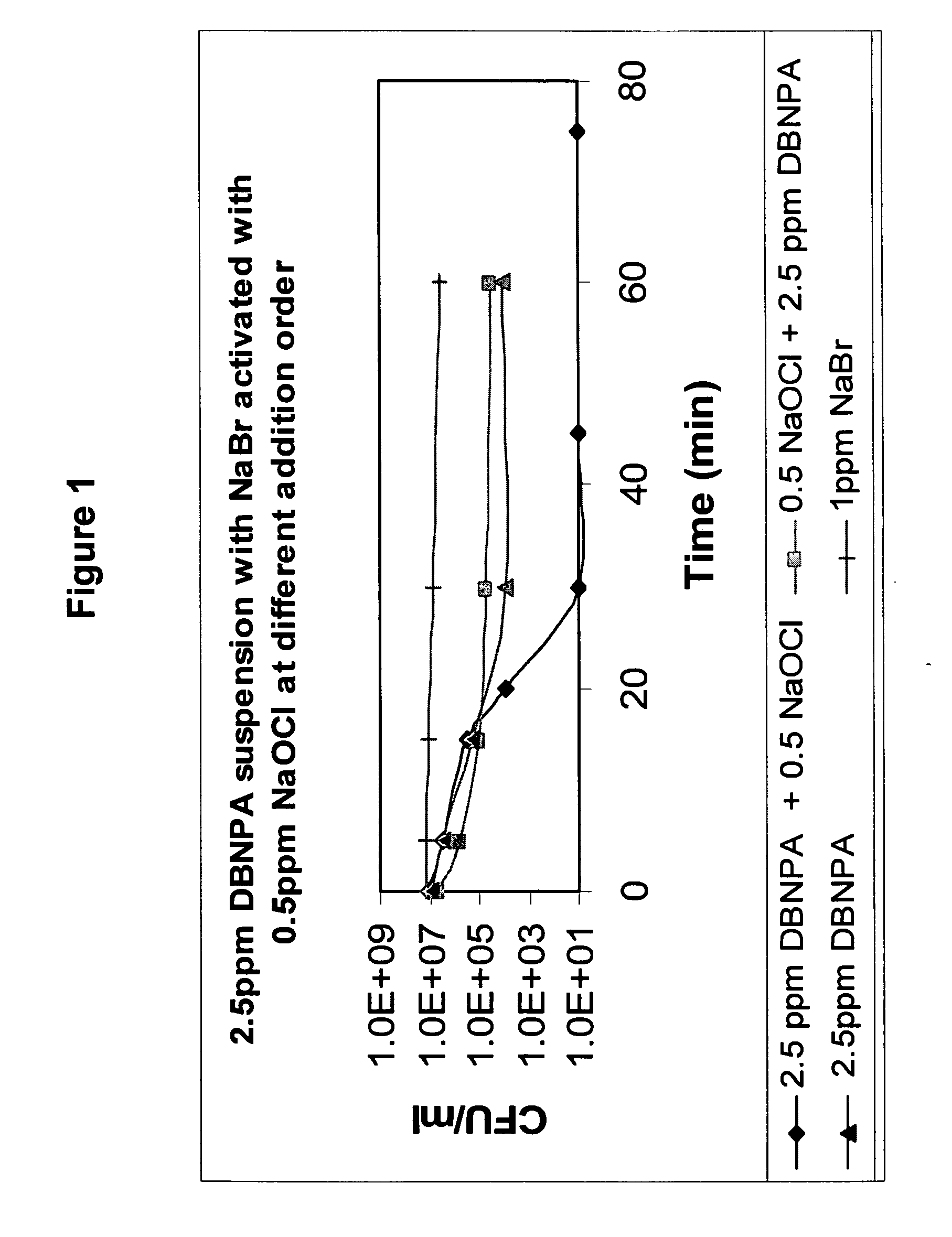Formulations Containing a Non-Oxidative Biocide and a Source of Active Halogen and Use Thereof In Water Treatment
a biocide and non-oxidative technology, applied in biocide, water treatment compounds, specific water treatment objectives, etc., can solve the problems of high instability of dbnpa in water, several limitations of chlorine based oxidants such as hypochlorous acid, and inability to react irreversibly with hypochlorous acid, etc., to achieve high water treatment
- Summary
- Abstract
- Description
- Claims
- Application Information
AI Technical Summary
Benefits of technology
Problems solved by technology
Method used
Image
Examples
example 1
A Homogenized Suspension of 40% DBNPA, 40% NaBr Brine and 1% Linear Alkyl Benzene Sulfonic Acid (Labs)
[0200]A NaBr aqueous solution (40% (brine), 295 grams) was mixed with a linear alkyl benzene sulfonic acid (LABS) solution (1%, 5 grams) and with 2-2-dibromo-3-nitrilopropionamide (DBNPA) (200 grams) in a 500 ml beaker. The mixture was homogenized in a dispersing system at 24,000 rpm for 2 minutes. A triphasic “foam” (suspension with air inside) was obtained, having a density of about 1.4 kg / liter. The mixture was stored for one week in a 500 ml graduated cylinder. No settling of the solid was observed and the suspension remained homogeneous.
example 2
A Homogenized Suspension of 55% DBNPA, 40% NaBr Brine and 0.55% Xanthan Gum
[0201]A NaBr aqueous solution (40% (brine), 270 grams) was mixed with xanthan gum (1.5 grams) and DBNPA (330 grams) in a 500 ml beaker. The mixture was homogenized in a dispersing system, at 10,000 rpm for 2 minutes and a suspension was obtained. The average particle size of the DBNPA in the suspension was about 180 μm. The density of the suspension was 1.7 Kg / liter. The suspension was easily poured and pumped using a peristaltic pump.
[0202]The suspension was stored for one month at ambient temperature in a 500 ml graduated cylinder, and another batch was stored for one week at 50° C. The density of the upper and lower part of the suspension was in the range of 1.68-1.70 Kg / liter in both cases, indicating there was no settling of the DBNPA.
example 3
A Homogenized Suspension of 66% DBNPA, 40% NaBr Brine, and 0.74% Xanthan Gum
[0203]A NaBr aqueous solution (40% (brine), 403 grams) was mixed with xanthan gum (3 grams) and DBNPA (817 grams) in a 800 ml beaker. The mixture was homogenized in a dispersing system, with S25-25 GM dispersing element at 24,000 rpm for 2 minutes, to thereby obtain a suspension. The mixture was easily poured and pumped with a peristaltic pump.
PUM
| Property | Measurement | Unit |
|---|---|---|
| particle size | aaaaa | aaaaa |
| pH | aaaaa | aaaaa |
| temperature | aaaaa | aaaaa |
Abstract
Description
Claims
Application Information
 Login to View More
Login to View More - R&D
- Intellectual Property
- Life Sciences
- Materials
- Tech Scout
- Unparalleled Data Quality
- Higher Quality Content
- 60% Fewer Hallucinations
Browse by: Latest US Patents, China's latest patents, Technical Efficacy Thesaurus, Application Domain, Technology Topic, Popular Technical Reports.
© 2025 PatSnap. All rights reserved.Legal|Privacy policy|Modern Slavery Act Transparency Statement|Sitemap|About US| Contact US: help@patsnap.com



